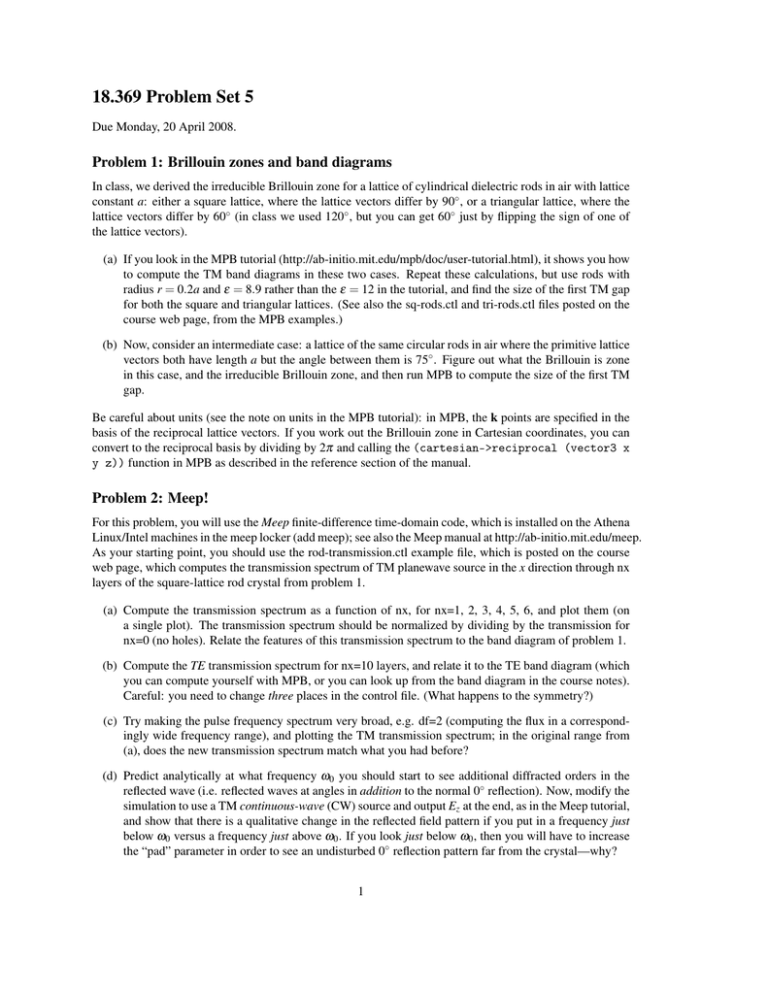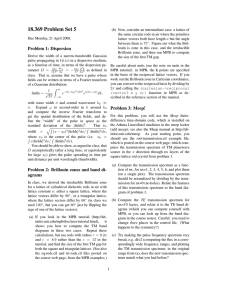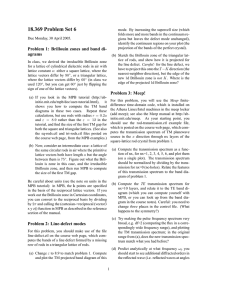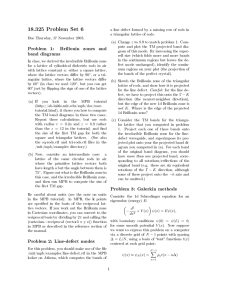18.369 Problem Set 5 Problem 1: Brillouin zones and band diagrams
advertisement

18.369 Problem Set 5 Due Monday, 20 April 2008. Problem 1: Brillouin zones and band diagrams In class, we derived the irreducible Brillouin zone for a lattice of cylindrical dielectric rods in air with lattice constant a: either a square lattice, where the lattice vectors differ by 90◦ , or a triangular lattice, where the lattice vectors differ by 60◦ (in class we used 120◦ , but you can get 60◦ just by flipping the sign of one of the lattice vectors). (a) If you look in the MPB tutorial (http://ab-initio.mit.edu/mpb/doc/user-tutorial.html), it shows you how to compute the TM band diagrams in these two cases. Repeat these calculations, but use rods with radius r = 0.2a and ε = 8.9 rather than the ε = 12 in the tutorial, and find the size of the first TM gap for both the square and triangular lattices. (See also the sq-rods.ctl and tri-rods.ctl files posted on the course web page, from the MPB examples.) (b) Now, consider an intermediate case: a lattice of the same circular rods in air where the primitive lattice vectors both have length a but the angle between them is 75◦ . Figure out what the Brillouin is zone in this case, and the irreducible Brillouin zone, and then run MPB to compute the size of the first TM gap. Be careful about units (see the note on units in the MPB tutorial): in MPB, the k points are specified in the basis of the reciprocal lattice vectors. If you work out the Brillouin zone in Cartesian coordinates, you can convert to the reciprocal basis by dividing by 2π and calling the (cartesian->reciprocal (vector3 x y z)) function in MPB as described in the reference section of the manual. Problem 2: Meep! For this problem, you will use the Meep finite-difference time-domain code, which is installed on the Athena Linux/Intel machines in the meep locker (add meep); see also the Meep manual at http://ab-initio.mit.edu/meep. As your starting point, you should use the rod-transmission.ctl example file, which is posted on the course web page, which computes the transmission spectrum of TM planewave source in the x direction through nx layers of the square-lattice rod crystal from problem 1. (a) Compute the transmission spectrum as a function of nx, for nx=1, 2, 3, 4, 5, 6, and plot them (on a single plot). The transmission spectrum should be normalized by dividing by the transmission for nx=0 (no holes). Relate the features of this transmission spectrum to the band diagram of problem 1. (b) Compute the TE transmission spectrum for nx=10 layers, and relate it to the TE band diagram (which you can compute yourself with MPB, or you can look up from the band diagram in the course notes). Careful: you need to change three places in the control file. (What happens to the symmetry?) (c) Try making the pulse frequency spectrum very broad, e.g. df=2 (computing the flux in a correspondingly wide frequency range), and plotting the TM transmission spectrum; in the original range from (a), does the new transmission spectrum match what you had before? (d) Predict analytically at what frequency ω0 you should start to see additional diffracted orders in the reflected wave (i.e. reflected waves at angles in addition to the normal 0◦ reflection). Now, modify the simulation to use a TM continuous-wave (CW) source and output Ez at the end, as in the Meep tutorial, and show that there is a qualitative change in the reflected field pattern if you put in a frequency just below ω0 versus a frequency just above ω0 . If you look just below ω0 , then you will have to increase the “pad” parameter in order to see an undisturbed 0◦ reflection pattern far from the crystal—why? 1 Problem 3: Coupled-cavity waveguides Suppose that you have a periodic sequence of weakly coupled cavity resonators (for example, a sequence of point defects in a 2d crystal, separated by a few periods of bulk crystal). The field in the m-th resonator is approximately an eigenmode of the isolated cavity with some amplitude Am , where the isolated cavity has a frequency ω0 . Assuming weak nearest-neighbor coupling, the most general equation describing these amplitudes can be written in the form: 1 dAm = −iω0 Am − Am + αAm−1 + β Am+1 . dt τ where α, β , and τ are some constants to be determined. We can choose the field normalization so that |Am |2 is the energy in the m-th cavity. (a) Assuming time-reversal symmetry and conservation of energy (there is no place for the energy to go except to other cavities), constrain τ, α, and β as much as possible. (b) This system has discrete translational symmetry (the equations are identical for each m, i.e. invariant under translation m → m − n for any n). What are the irreducible representations of this translation symmetry group? (c) Assume Am is an eigenmode with a frequency ω, and choose the eigenmodes to be partner functions of your irreducible representations. Plug this into the equation for dAm /dt , and solve for the eigenmodes and the eigenvalues. Sketch the eigenvalues (the dispersion relation). (d) As we increase the separation of the cavities, assuming that the modes are exponentially confined, the coupling between the cavities (α and β ) should decrease exponentially fast. What happens to the dispersion relation and the group velocity? 2









